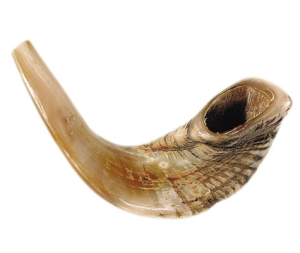Rosh Hashanah is celebrated on the first of Tishrei in accordance to Leviticus 23: Speak unto the children of Israel, saying: In the seventh month, in the first day of the month, shall be a solemn rest unto you, a memorial proclaimed with the blast of horns, a holy convocation. Ye shall do no manner of servile work; and ye shall bring an offering made by fire unto the LORD. The words “Rosh Hashanah” do not appear in the Torah, but rather the day is described as yom teruah= the Day of blowing the Horn (Numbers 29:1) or zichron teruah= a Memorial with the blast of Horns (Leviticus 23:24).
A horn should be blown for all festivals and new moons (Numbers 10:10), but on Rosh Hashanah is it must be a ram’s horn. Maimonides (1135-1204 CE) felt that the impetus to blow the Shofar was to cause the hearts of the people to tremble and thus stir them to repentance. In contrast, the Babylonian Talmud (Rosh Hashanah III: 3) explains that the Shofar serves as a reminder of the substitution of a ram for the sacrifice of Isaac by his father Abraham. This animal is indeed a seminal link between the Jew and God during Rosh Hashanah at the beginning of the spiritual year, as well as Pesach, which marks the beginning of the agricultural year. Jew’s mark their coming of age by celebrating a Bar/Bat Mitzvah. The secular world, through Homer’s Iliad, has adopted the golden fleece as a symbolic challenge to pursue at one’s coming of age.
The Shofar sounds are restricted to only two notes: G and D. The Tekiah and Teruah sounds only are mentioned in the Tanach and the sequence was originally only blown three times. First to acknowledge God as Ruler of the world (malchuyoth = kingdom), second to remember the binding of Isaac (zichronoth = remembrance), and third to remember the duty to blow the Shofar, (shofaroth = sounding the Shofar). Psalm 89:16 reads: Happy is the people that know the joyful sound.
Copyright David ben Manasseh


